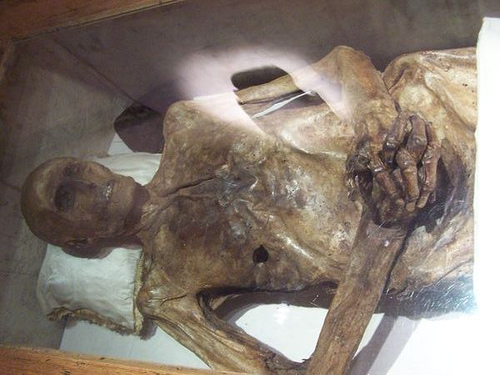
Because they’re stationary and have a smooth, saucerlike shape, lenticular clouds are often reported as UFOs. These photos were taken in New Hampshire (above) and New Mexico.


Because they’re stationary and have a smooth, saucerlike shape, lenticular clouds are often reported as UFOs. These photos were taken in New Hampshire (above) and New Mexico.

In the 1990s, residents of Taos, N.M., and Kokomo, Ind., began to report an invasive low-frequency noise, which they likened to a distant idling diesel engine. Others have since reported the sensation elsewhere, especially in Europe. Strangely, the sound is often worse indoors, and ordinary microphones don’t detect it.
Possible explanations have included everything from meteors to submarines, but so far there’s been no large-scale investigation. For now the phenomenon is simply called “the Hum.”
When he wasn’t escaping straitjackets, Harry Houdini spent a lot of time debunking spiritualists.
Shortly before his death, he made a pact with his wife, Bess: If possible, he would contact her from the other side and deliver a prearranged coded message.
When he died, Bess lit a candle beside his photograph and kept it burning for 10 years, holding séances every Halloween to test the pact. Harry never spoke.
In 1936, after a final attempt on the roof of the Knickerbocker Hotel, Bess put out the candle.
“Ten years is long enough to wait for any man,” she said.
No science fiction film has ever been named best picture.
In his 1647 Del Luce Animalium, Danish physician Thomas Bartholin noted a great lost opportunity for animal husbandry.
In France’s Montpellier market, he wrote, a chicken had appeared whose feathers glowed. Killed for closer study, the cock “shone on all parts of its body with a remarkably strong light.”
At the same time, he said, an Italian hen from Montebello “shone like a ball of white fire.”
It was a pity, Bartholin noted, that the two birds couldn’t be bred together, “for we might then have obtained a breed of incandescent fowls.” And saved money on candles.

Artist Jackson Pollock put his canvas on the floor and poured paint on it from a height.
Critics called him “Jack the Dripper.”
The Bavarian village of Oberammergau has a special deal with God. While the bubonic plague was ravaging Europe, the town’s citizens vowed that if they were spared they would perform a play every 10 years depicting the life and death of Jesus.
God, apparently, accepted. The death rate among adults rose from 1 in October 1632 to 20 in March 1633, but then it dropped again to 1 in July 1633.
True to their word, the villagers staged a play in 1634, and they’ve done so every 10 years ever since.
Excerpts from student exams in the 19th century:
— From Mark Twain, “English as She Is Taught: Being Genuine Answers to Examination Questions in Our Public Schools,” 1887

Christian Friedrich von Kahlbutz is looking remarkably fit for his age. The Prussian knight died in 1702 and his body hasn’t decayed.
No one knows why. He wasn’t embalmed. A legend says it’s God’s punishment for an oath he broke while living. Scientists think he lost a lot of blood before dying and that the local soil lacked materials that would promote decay. But that doesn’t explain why other bodies nearby did rot.
A Latin palindrome:
IN GIRUM IMUS NOCTE ET CONSUMIMUR IGNI.
(“We enter the circle at night and are consumed by fire.”)
It was said to describe the behavior of moths.